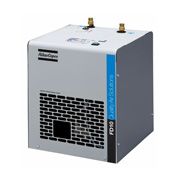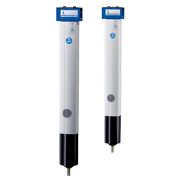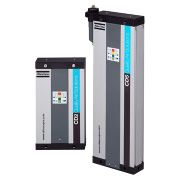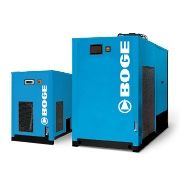Compressed air dryer
Our offer includes compressed air dryers from renowned and recognized manufacturers: Atlas Copco, BEKO Technologies, BOGE and FriulAir.
Compressed air dryers have been divided into several groups due to the way the dryer works:
- refrigeration dryers
- adsorptive
- membrane
- hybrid - a combination of refrigerant and adsorption dryer
Our compressed air dryers reliably, economically and energy-efficiently protect your infrastructure and production processes.
The air dryer for the compressor is an effective device that helps to obtain dry and clean compressed air, but you should not forget to use filters or a cyclone separator before the dryer, final filters after the dryer or condensate drains at tanks or on compressed air installations to get the most treated air for specific compressed air applications.
Refrigeration dryers
it is a group of dryers which, in the process of drying compressed air, use a refrigeration system with a refrigerant compressor, heat exchanger, condenser and condensate drain, which was created as a result of water condensation in the dried air.
The dryer for the refrigeration compressor is normally set to dry compressed air to the pressure dew point (CPR) + 3 degrees C. According to the ISO 8573-1 standards, it is the 4th class of compressed air purity for water particles. The CPR value determines the limit below which water may condense again in the compressed air. It should be remembered that the compressed air at the dryer outlet is reheated in the exchanger to approx. 35 degrees C.
During the correct selection of a compressed air refrigerant dryer, its nominal flow must be corrected by:
- correction factor for the compressed air temperature at the inlet to the dryer (the higher than 35 degrees C, the nominal flow of the dryer decreases)
- correction factor for the ambient temperature of the dehumidifier's operation (the higher than 25 degrees C, the nominal flow of the dehumidifier drops)
- correction factor for compressed air pressure at the dryer inlet (7 bar is the nominal value, the higher the pressure, the nominal flow of the dryer increases, the lower than 7 bar the nominal flow of the dryer decreases)
As standard, refrigeration dryers work up to a pressure of max. 16 bar, but there are also versions that can work up to a pressure of max. 40 bar - please send an inquiry to see the offer.
It often happens that the above-mentioned the correction factors are not taken into account, which results in the wrong choice of the refrigerant dryer and its cooling capacity for operation with the compressor.
The exact parameters of the correction factors are always given in the dryer datasheet and must be absolutely used when selecting the refrigerant dryer.
All the refrigeration dryers we offer are based on the same principle, so how do they differ? First of all, the construction and materials used for their production, e.g. the material from which the exchanger is made, the condenser, what the refrigerant compressor is mounted, how much refrigerant is used or what is the condensate drain installed - a bacon or a time-controlled pressure valve.
You will find all these details in our technical details for each dehumidifier we offer. The best dehumidifiers are characterized by the lowest pressure drop of compressed air in the drying process, the use of a bekomat condensate drain, as well as ensure the lowest energy consumption in the drying process, which allows us to protect our natural environment.
Like inverter compressors, refrigeration dryers can also smoothly adjust their operation and the amount of electricity used to the user's needs - the amount of compressed air currently consumed in production processes. This is done through an advanced controller that constantly monitors the flow of compressed air along with its parameters and controls the operation of the cooling compressor and the fan so that the desired CPR is always obtained with the lowest possible energy consumption. This is commonly used in refrigeration dryers with a high nominal compressed air flow.
Refrigeration dryers are almost maintenance-free devices, you only need to remember to clean them periodically, replace the condensate drain and check the cooling system.
All dehumidifiers we offer are made in the EU.
Desiccant dryer for adsorption compressor
These are compressed air dryers whose operating principle is based on the adsorption process during the compressed flow through the dryer. Our offer presented on our website concerns adsorption dryers regenerated with the use of compressed, dried air. It is the most frequently used method of bed regeneration in an adsorption dryer.
For special applications, we can also offer our customers adsorption dryers regenerated by heating the bed - these are usually dryers with very high nominal flows and usually used with oil-free compressors. Adsorption dryers will allow to obtain CPR at the level of - 70 ° C, i.e. 1 class of compressed air purity according to ISO 8573-1. As a standard, adsorption dryers are set to obtain CPR - 40 ° C, i.e. 2 class of compressed air purity according to ISO 8573-1.
The selection of an adsorption dryer should also be made using the following correction factors:
- correction factor for the compressed air temperature at the inlet to the dryer (the higher than 35 degrees C, the nominal flow of the dryer decreases)
- correction factor for compressed air pressure at the dryer inlet (7 bar is the nominal value, the higher the pressure, the nominal flow of the dryer increases, the lower than 7 bar the nominal flow of the dryer decreases)
Desiccant dryers regenerated with the use of compressed air by means of a standard work up to a pressure of max. 16 bar.
In the case of adsorption dryers regenerated with a compressed air bleed, the ambient temperature of the dryer operation is of little importance as they are not air-cooled dryers like refrigeration dryers.
The process of drying by an air dryer to an adsorption compressor regenerated with a compressed air bleed is largely based on the flow of compressed air through one column and simultaneous regeneration of the bed in the second column. The whole process takes a fixed time and then the work in two columns of the dryer changes. The first one, which dried the compressed air, is regenerated and the second one, after the regeneration process, dries the compressed air.
The drying process, to a large extent, consists in absorbing moisture by a special sorbent in the columns (absorbs like a sponge), then after switching to regeneration it is cleaned by dried compressed air - now compressed, purified air absorbs moisture from the sorbent and is ejected outside. Characteristic for an adsorption dryer, a regenerated bleed of compressed air is a continuous hiss - it is a bleed of compressed air from a regenerated column.
Drying - regeneration cycles are usually factory set and cannot last. It always involves the irretrievable loss of compressed air that has already been dried - therefore, when choosing an adsorption dryer of this type, the user must be aware of the additional consumption of compressed air produced by the compressor. The amount of compressed air consumption for the regeneration process is up to max. 18% of the nominal compressed air flow.
Therefore, when choosing an adsorption dryer, it is worth equipping it with an optional CPR measurement system and controlling the operation of the adsorption dryer on the basis of the obtained CPR - this allows to minimize the loss of compressed air in the regeneration process of the sorbent column. In addition, the dryer equipped in this way allows you to adjust (change) the CPR depending on the user's needs, which affects the time of operation of the drying column and the regeneration of the column after the drying process.
Reducing the amount of compressed air required to regenerate the dryer will reduce the amount of compressed air that must be produced for this purpose and thus also reduce the electricity consumption of the compressor - thus we protect the natural environment!
The desiccant dryer for the adsorption compressor consumes very little electricity, it is needed only for the operation of the controller and for driving the valves when switching and decompressing the columns.
All our adsorption dryers are equipped with a filter at the inlet of the dryer and a dust filter at the outlet of the dryer. These are very important elements of the entire system and taking care of their efficiency has a significant impact on the service life of the sorbent and the final quality of the compressed air.
The compressed air to be dried by the adsorption dryer must be filtered through a coalescing filter (0.01 micron) to remove the oil particles. The sorbent bed in the dryer is very sensitive and cannot come into contact with the oil, as this may lead to its irreversible destruction (the holes through which the sorbent particles absorb moisture will be clogged with oil particles and in the regeneration process it will not be cleaned).
1 micron dust filter Installed at the outlet of the compressed air from the dryer, its task is to clean the compressed air from any dust which is the result of the sorbent rubbing between itself during the flow of compressed air through the columns. Compressed air not cleaned of this dust could have a negative impact on the production processes taking place with the use of compressed air, as well as adversely affect the durability of compressed air powered devices.
It is also important to supply the adsorption dryer with compressed air free of liquid water particles - the sorbent used in the dryer might not be able to absorb such a large amount of water. Therefore, it is worth installing a cyclone separator with an automatic condensate drain in the initial compressed air treatment process, which can get rid of the already condensed water in compressed air in 99%.
Air dryer for a membrane compressor
Devices for mechanical drying of compressed air through the flow of compressed air through a specially constructed membrane, which results in retaining moisture particles. Membrane dryers are used wherever access to operational activities is very difficult or where there is a problem, e.g. power supply.
Membrane dryers are, similarly to adsorption dryers, regenerated by means of a compressed air release. The amount of compressed air consumption is related to the compressed air purity class according to ISO 8573-1 that we want to achieve and ranges from 10 to 20% of the nominal compressed air flow through the dryer. They are applicable for small flows of max. 2000 l / min.
CPR. which can be achieved with adsorption dryers binds to the CPR at the inlet of the membrane dryer. Thanks to the membrane dryers, we can obtain a CPR of -20 degrees C. - that is the 3rd class of compressed air purity according to the ISO 8573-1 standard.
The diaphragm compressor dryer, like the adsorption dryers, should be supplied with compressed air filtered from oil particles ( 0.01 micron filter ) and water particles (cyclone separator).
Membrane dryers are available in a column version for horizontal installation as well as a pipe version for horizontal installation, e.g. in hard-to-reach places such as locomotives or train carriages, e.g. Pendolino (compressed air is used there for e.g. opening and closing doors)
Hybrid compressor air dryer - Refrigeration + Adsorption Drying
The type of air dryer pneumatics is recommended to all those users who need in their production processes mostly compressed air with CPR. +3 degrees (i.e. class 4 according to ISO 8573-1), but also in some periods, e.g. in winter, they must lower their CPR to -20 ° C or, by the requirements of a variable production process, lower the dew point to -70 ° C (1 purity class according to ISO 8573-1).
Such a compressed air drying process allows to precisely match the quality and purity of the compressed air to the current requirements of production processes. When cleanliness class 4 is sufficient - all the work is done by the refrigerant dryer and the air dryer for the adsorption compressor does not take part in the drying process, which results in the lack of compressed air consumption in the regeneration process - this is the main idea behind the use of hybrid dryers which are a combination of a refrigeration dryer and a regenerated adsorption dryer compressed air bleed.
The user has two devices in one, thus reducing the space needed to install the device, the number of connections and efficiently uses electricity to power his dehumidifier.





Login and Registration Form